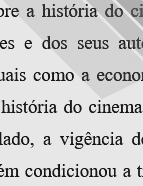

................................
The extensive work of Félix Ribeiro also focused on the writing of the first drafts and syntheses of the history of Portuguese cinema, dispersed across several monographs and texts published throughout the specialised press. His most significant work, published posthumously, fully illustrates his historiographical activity and style: Filmes, Figuras e Factos do Cinema Português 1896-1949 [Films, Figures and Facts of Portuguese Cinema 1896-1949] (Cinemateca Portuguesa, 1983) and is a valuable report of decades of data collection on the themes to which the title alludes, bringing together credits, images, press prints and backstage stories.
Manuel Félix Ribeiro was a sort of first "official film chronicler of the kingdom", that is, a proto historian of Portuguese cinema who bound his personal version to the official version of the Cinemateca Nacional. As a pioneer, he defined the structure of a narrative on the history of the first fifty years of Portuguese cinema which, in essence, is still in force today in most of the main Portuguese historiographical publications.
Jorge Pelayo played an equally important role in this first phase of the historiographical construction of Portuguese cinema. In addition to collaborating in the main periodicals specialising in cinema, and besides being the organiser of important classical cinema sessions and retrospectives of Portuguese sound cinema, Pelayo also organised the Filmoteca [Film library] of the SNI/SEIT with great patience. However, the work that granted him a key footing in the history of Portuguese cinema was published in 1966 and has already seen two updated and expanded editions (1985 and 1998): Bibliografia Portuguesa de Cinema [The Portuguese Bibliography of Cinema] is an indispensable tool - as it was for the writing of this text - for any work on the history of Portuguese cinema. The change of the subtitle of the first edition (Bases para um ensaio teórico [Bases for a theoretical essay]) to Uma visão cronológica e analítica [A chronological and analytical view] corresponds to a deliberate methodological mutation that guided the second and third editions.
